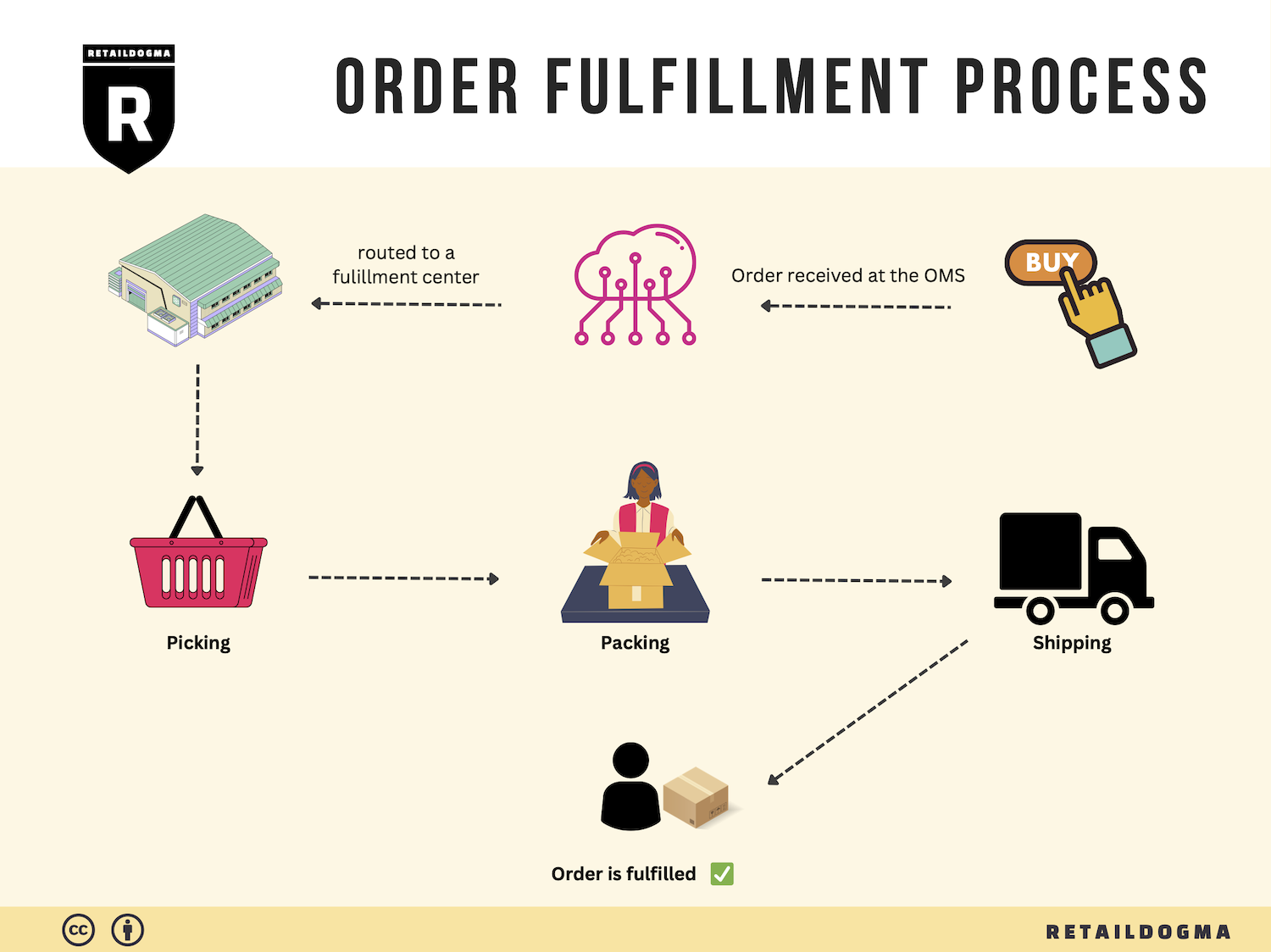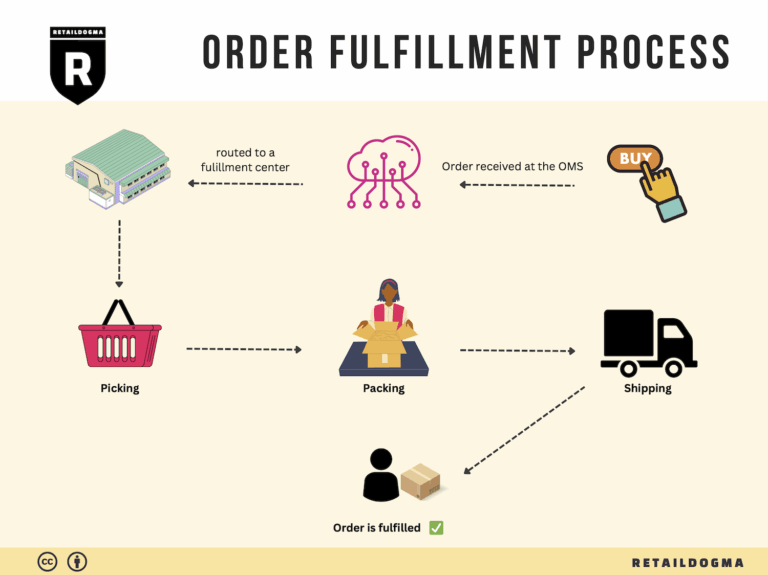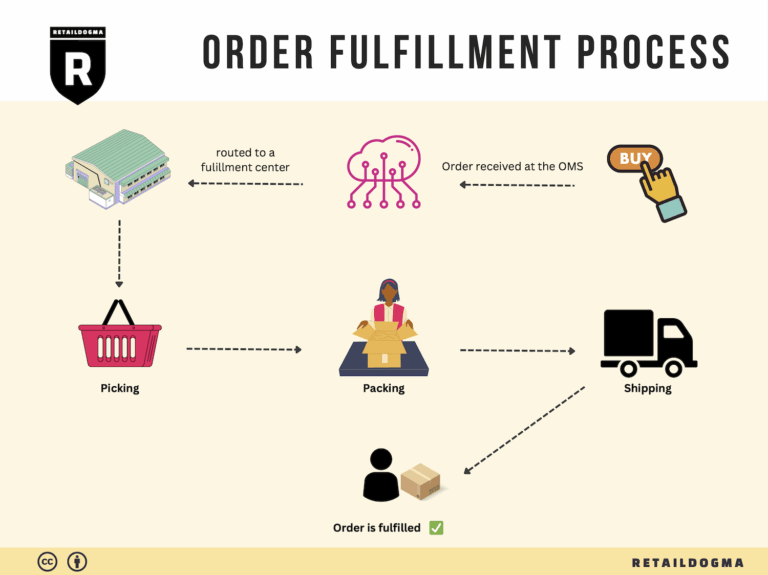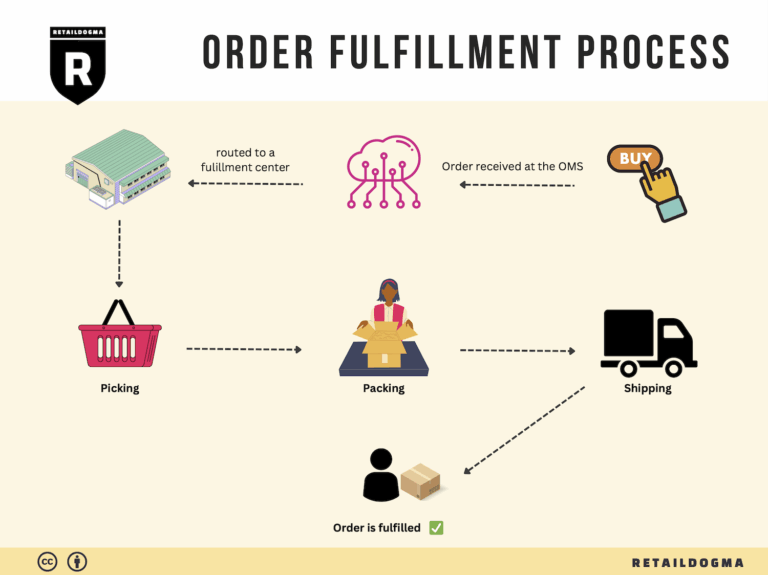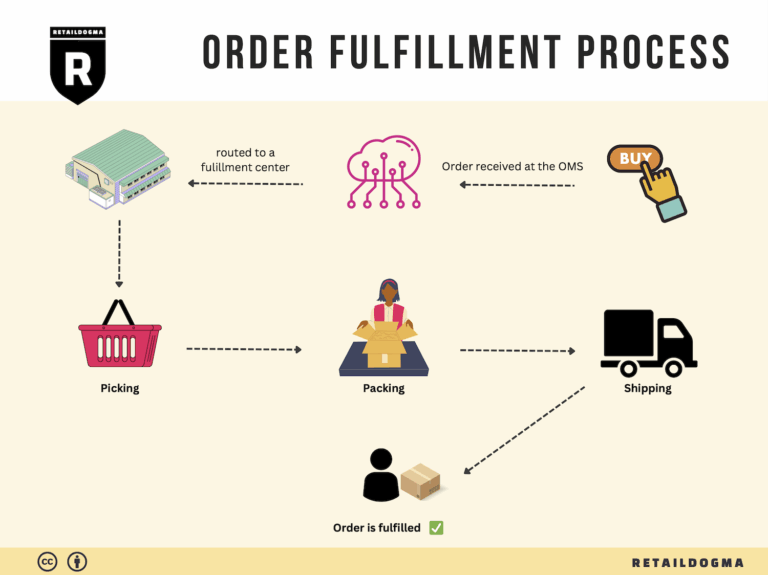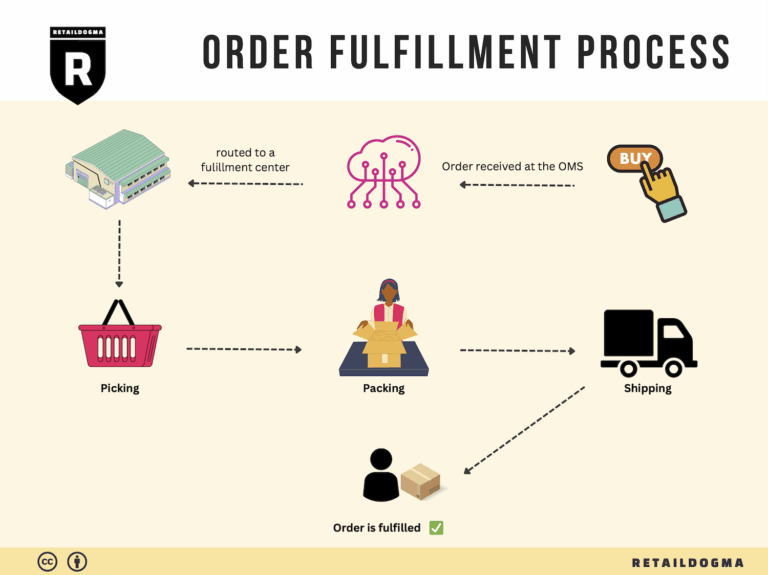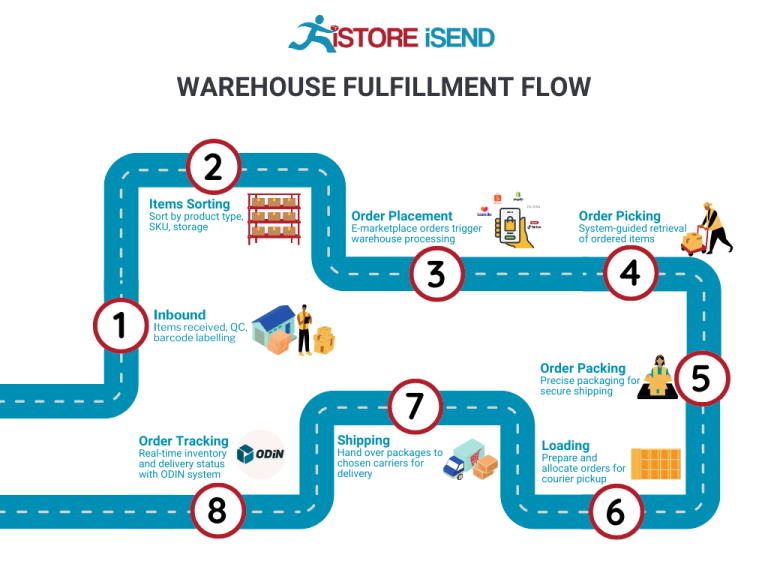How Order Fulfillment Works: A Step-by-Step Guide for Businesses
What is E-commerce Fulfillment? An Introduction for Growing Businesses
Understanding the Fulfillment Process
As an e-commerce business owner, you may find yourself grappling with the complexities of packing and shipping orders. Managing inventory, ensuring timely deliveries, and keeping customers satisfied can quickly become overwhelming. This is where e-commerce fulfillment comes into play—a crucial aspect of your operations that can make or break your business.
At its core, fulfillment is the process of getting a product from your warehouse or fulfillment center to the customer’s doorstep. It encompasses everything from receiving and storing inventory to picking, packing, and shipping orders. As your business grows, understanding the nuances of fulfillment becomes vital for maintaining efficiency and customer satisfaction.
In this guide, we will explore the various models of e-commerce fulfillment, including third-party logistics (3PL) and Fulfillment by Amazon (FBA). Each model has its unique advantages and challenges, and knowing which one aligns best with your business goals is essential.
We will delve into the core services that fulfillment providers offer, such as inventory management, order processing, and returns handling. These services can significantly impact your operational efficiency and customer experience, making it important to select the right mix for your specific needs.
Choosing the right fulfillment partner is another critical aspect we’ll cover. Factors such as location, technology capabilities, and customer support play a significant role in ensuring your fulfillment process runs smoothly. We’ll provide practical tips on how to evaluate potential partners and what questions to ask to make an informed decision.
Pricing is often a concern for growing businesses, and we’ll break down the various costs associated with fulfillment services. Understanding the pricing structure will help you budget effectively and identify opportunities to optimize your spending.
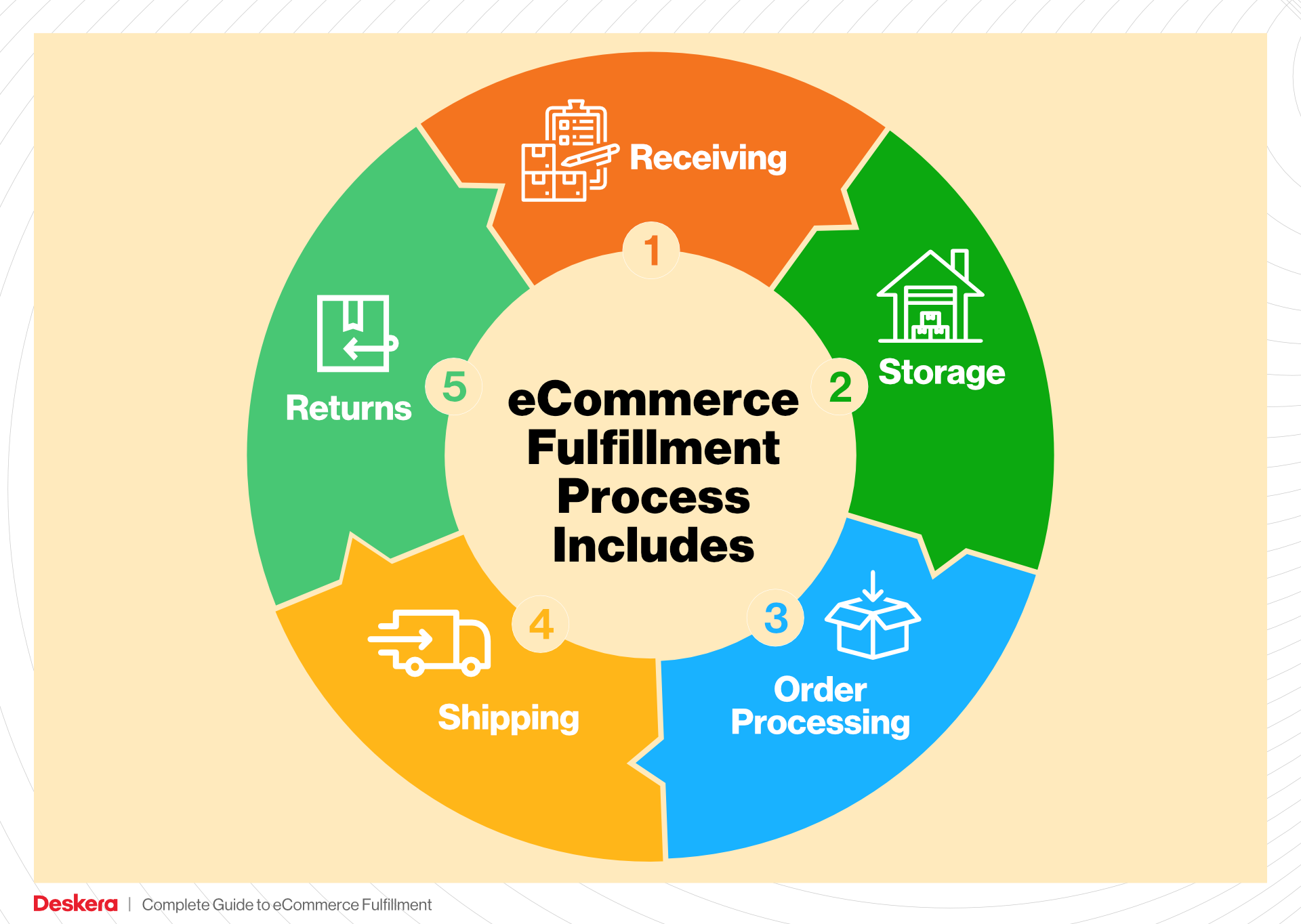
Ultimately, the goal of this guide is to empower you to make smart decisions about your logistics. By understanding the fulfillment landscape, you can streamline your operations, improve customer satisfaction, and position your business for scalable growth. Let’s dive into the world of e-commerce fulfillment and unlock the potential for your business to thrive.
What You’ll Learn In This Guide
- What is E-commerce Fulfillment? An Introduction for Growing Businesses
- The Order Fulfillment Process: From ‘Buy’ Button to Customer’s Door
- Comparing Fulfillment Models: In-House vs. 3PL vs. Dropshipping
- A Deep Dive into Amazon FBA: Pros, Cons, and Who It’s For
- Core Services Offered by Fulfillment Centers
- How to Choose a Fulfillment Partner: A 6-Point Checklist
- Understanding Fulfillment Pricing: A Breakdown of Common Fees
- Frequently Asked Questions (FAQs) about Fulfillment
- Conclusion: Is Outsourcing Fulfillment the Right Move for Your Business?
- Important Disclaimer
The Order Fulfillment Process: From ‘Buy’ Button to Customer’s Door
1. Receiving Inventory
The order fulfillment process begins with receiving inventory from suppliers. This step involves checking incoming shipments against purchase orders to ensure that the correct items and quantities have been delivered. Upon receipt, products are typically labeled with Stock Keeping Units (SKUs) for easy identification and tracking within the warehouse.
Importance: Receiving inventory accurately is crucial as it establishes the foundation for all subsequent operations. Mistakes at this stage can lead to inventory discrepancies, which may result in stockouts or overstock situations, directly affecting customer satisfaction and profitability.
Key Term: SKU (Stock Keeping Unit) – A unique identifier for each product, crucial for inventory management and tracking.
2. Warehouse Storage
Once the inventory has been received and verified, it is then organized and stored in the warehouse. This process involves strategically placing products in designated storage areas to optimize space utilization and streamline future picking processes. Effective warehouse layout design, including the use of shelving, bins, and pallets, plays a critical role in this step.
Importance: Proper storage ensures that items are easily accessible, which reduces the time taken to fulfill orders. Efficient storage solutions also help minimize the risk of damage and loss, allowing businesses to maintain higher levels of inventory accuracy and operational efficiency.
Key Term: Location Code – A systematic labeling method that indicates where each SKU is stored within the warehouse, facilitating quick access and retrieval.
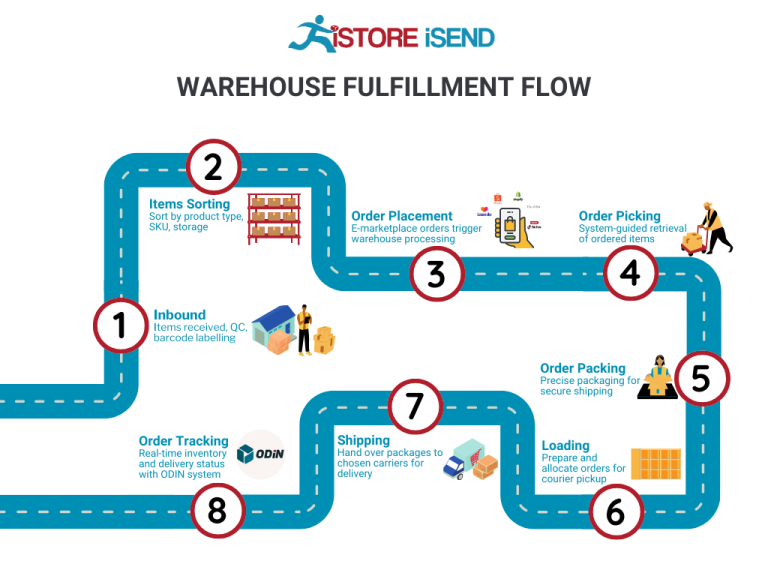
3. Order Picking
The next step in the fulfillment process is order picking, where items are selected from their storage locations based on incoming customer orders. This can be done using various methods, such as single order picking, batch picking, or wave picking, depending on the order volume and warehouse layout. Pick lists, which detail the items and quantities needed for each order, are generated to guide staff during this process.
Importance: Efficient order picking is vital for meeting customer expectations regarding order accuracy and delivery speed. Delays or errors in this stage can lead to dissatisfied customers, increased returns, and added operational costs.
Key Term: Pick List – A document or digital tool that outlines the items to be retrieved for fulfilling specific customer orders, serving as a guide for warehouse staff.
4. Order Packing
After items have been picked, they are moved to the packing station, where they are prepared for shipment. This step involves checking items against the order to ensure accuracy, selecting appropriate packaging materials, and securely packing the items to prevent damage during transit. Additionally, packing slips and shipping labels are generated and attached to the packages.
Importance: Proper packing is essential for protecting products during shipping and ensuring they arrive in excellent condition. It also serves as an opportunity to enhance the customer experience through branded packaging or including promotional materials, which can encourage repeat business.
Key Term: Packing Slip – A document included in the shipment that itemizes the contents of the package, serving as a reference for both the seller and the customer.
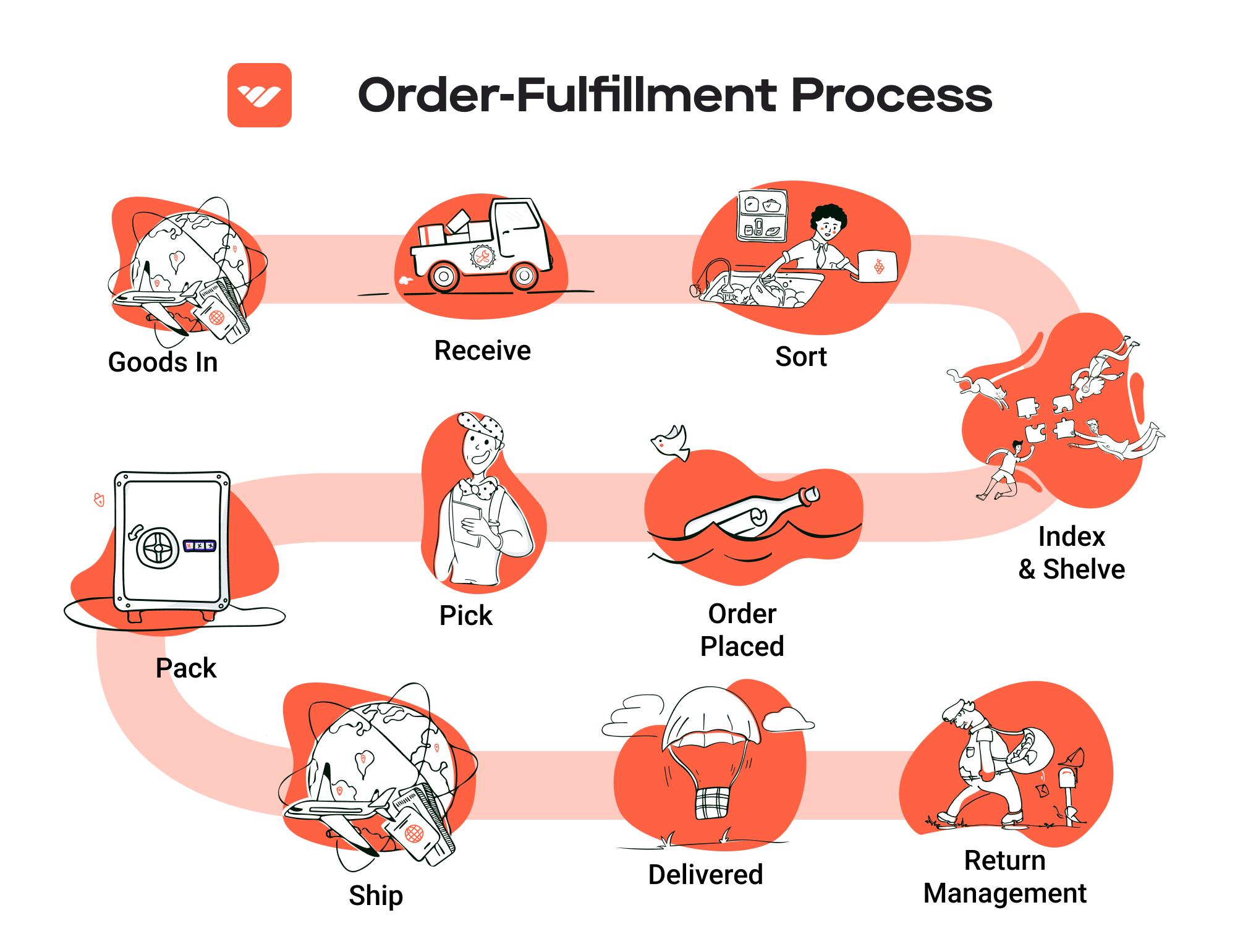
5. Shipping & Delivery
The final step in the order fulfillment process is shipping, where packed orders are dispatched to customers. This stage involves selecting a suitable shipping carrier based on factors such as cost, speed, and reliability. Effective logistics management, including tracking shipments and managing delivery schedules, is critical to ensure that orders reach customers on time.
Importance: Timely and reliable shipping directly impacts customer satisfaction and can significantly influence a brand’s reputation. A well-executed shipping process not only fulfills the customer’s order but also enhances their overall shopping experience, leading to increased loyalty and repeat purchases.
Key Term: Last-Mile Delivery – The final segment of the shipping process, which involves transporting the package from a distribution center to the customer’s doorstep, often considered the most critical part of the fulfillment process.
By understanding and optimizing each of these steps, e-commerce businesses can enhance their order fulfillment processes, leading to improved customer satisfaction and operational efficiency. Whether you are a small startup or a larger enterprise, a well-structured fulfillment strategy is vital for scaling your operations and achieving long-term success in the competitive e-commerce landscape.
Comparing Fulfillment Models: In-House vs. 3PL vs. Dropshipping
Fulfillment Model Comparison
| Model | Who Handles Inventory | Best For (Business Stage) | Key Advantage | Key Disadvantage |
|---|---|---|---|---|
| In-House Fulfillment | The business itself | Startups to established brands | Full control over operations and inventory | High overhead costs and resource-intensive |
| Third-Party Logistics (3PL) | 3PL provider | Scaling businesses | Cost-effective and scalable | Less control over fulfillment processes |
| Dropshipping | Supplier | New and small businesses | Low upfront investment and risk | Lower profit margins and reliance on suppliers |
In-House Fulfillment
In-house fulfillment involves managing the entire logistics process within your own organization. This model is often adopted by startups or established brands that prioritize control over their operations, inventory, and customer experience. Businesses that choose in-house fulfillment have the advantage of tailoring their processes to meet specific needs, ensuring quality control and brand consistency. However, this model can be resource-intensive, requiring significant investment in warehousing, staff, and technology. Additionally, the complexities of managing inventory, shipping logistics, and order processing can strain operational capabilities, particularly as order volumes increase. For businesses with a stable demand and sufficient resources, in-house fulfillment can provide a strong foundation for customer satisfaction and brand loyalty.
Third-Party Logistics (3PL)
Third-party logistics (3PL) providers, such as Verde Fulfillment USA, offer a comprehensive solution for e-commerce businesses looking to scale efficiently. By outsourcing warehousing, order fulfillment, and shipping to a 3PL, companies can focus on their core competencies like marketing and product development. This model is particularly beneficial for businesses experiencing rapid growth, as it allows for scalability without the burden of managing logistics in-house. 3PL providers typically have advanced technology stacks and strategic warehouse locations, enabling faster shipping and improved inventory management. However, partnering with a 3PL can lead to reduced control over the fulfillment process. Businesses may find themselves reliant on their partner’s capabilities and performance, which can impact customer satisfaction if not managed properly. Thus, selecting the right 3PL is critical to ensure alignment with business goals and customer expectations.
Dropshipping
Dropshipping is a fulfillment model where the retailer does not hold inventory but instead relies on suppliers to fulfill customer orders directly. This model is especially appealing to new or small businesses due to its low upfront investment and minimal risk. Retailers can offer a wide range of products without the need for warehousing, making it easier to test different markets and niches. However, the dropshipping model has its drawbacks, primarily related to profit margins and inventory management. Retailers often face lower margins due to the costs associated with third-party suppliers, and they have limited control over product quality, shipping times, and customer service. Additionally, reliance on suppliers can lead to challenges in managing stock levels, resulting in potential stockouts or delays that can frustrate customers. For entrepreneurs looking to enter the market quickly and with less financial commitment, dropshipping can be an effective strategy, provided they are aware of and can navigate its inherent challenges.
Conclusion
When considering which fulfillment model to adopt, e-commerce business owners must weigh their specific needs, resources, and growth aspirations. In-house fulfillment provides control but requires significant investment and operational capacity. Third-party logistics offer scalability and efficiency, but businesses must choose their partners wisely to maintain service quality. Dropshipping presents a low-risk entry point into e-commerce but can result in lower profit margins and less control over the customer experience. Ultimately, the right choice will depend on the unique circumstances of each business, including their stage of growth, product offerings, and operational capabilities.
A Deep Dive into Amazon FBA: Pros, Cons, and Who It’s For
Understanding Fulfillment by Amazon (FBA)
Fulfillment by Amazon (FBA) is a service provided by Amazon that allows sellers to store their products in Amazon’s fulfillment centers. Amazon then takes care of storage, packaging, and shipping of the products directly to customers. This service has become increasingly popular among e-commerce businesses looking to leverage Amazon’s extensive logistics network and customer base.
When a customer orders a product that is fulfilled by Amazon, the process is seamless. The order is processed, packed, and shipped from an Amazon warehouse, and Amazon handles all customer service and returns. This not only simplifies logistics for sellers but also enhances customer experience by providing fast shipping options, including Amazon Prime.
How FBA Works
-
Setup: Sellers create an Amazon seller account and enroll in FBA. They list their products on Amazon and prepare them for shipment to Amazon’s fulfillment centers.
-
Inventory Shipment: Sellers send their inventory to Amazon’s warehouses. Amazon provides guidelines on how to package and label products correctly to ensure they are accepted.
-
Storage: Once the inventory is received, Amazon stores it in their fulfillment centers. Products are then listed as “Fulfilled by Amazon” on the marketplace.
-
Order Processing: When a customer places an order, Amazon picks, packs, and ships the product on behalf of the seller.
-
Customer Service: Amazon manages customer inquiries, returns, and refunds, providing a hassle-free experience for sellers.
-
Payment: After the sale, Amazon deducts its fees and remits the remaining funds to the seller, typically on a bi-weekly basis.
Pros of Using FBA
1. Prime Eligibility
One of the most significant advantages of FBA is that products become eligible for Amazon Prime. This means that customers with Prime memberships can access free two-day shipping, which significantly increases the chances of sales and improves customer satisfaction.
2. Customer Trust
Amazon is a trusted name in e-commerce. When customers see that a product is fulfilled by Amazon, they are more likely to trust the purchase. This trust can lead to higher conversion rates and repeat customers.
3. Multi-Channel Fulfillment
FBA isn’t limited to just Amazon.com. Sellers can also use FBA to fulfill orders from other sales channels, such as their own e-commerce websites or other marketplaces. This multi-channel fulfillment capability helps streamline operations and maintain consistent inventory management across platforms.
4. Scalability
FBA allows sellers to scale their businesses without the need to invest heavily in logistics infrastructure. As demand for products increases, sellers can simply send more inventory to Amazon’s warehouses, allowing them to focus on marketing and sales.
5. Time-Saving
Outsourcing fulfillment to Amazon saves sellers time and resources. Instead of managing logistics, packaging, and shipping, sellers can concentrate on growing their business.
Cons of Using FBA
1. High Fees
While FBA offers many benefits, it comes with significant fees that can eat into profit margins. These include storage fees for inventory, fulfillment fees per unit sold, and additional costs for optional services. Sellers must carefully calculate these fees to ensure profitability.
2. Strict Inventory Rules
Amazon has stringent inventory management policies. Sellers must adhere to guidelines regarding product preparation, labeling, and storage limits. Failure to comply can result in additional charges or removal of inventory.
3. Commingling Risks
FBA uses a commingled inventory model, meaning that sellers’ products may be mixed with those of other sellers. This can lead to issues such as receiving returns for products that are not yours or customer complaints about product quality, impacting brand reputation.
4. Lack of Control
By using FBA, sellers relinquish some control over the fulfillment process. They cannot manage shipping times, packaging choices, or customer service directly, which can be a concern for brands that prioritize a specific customer experience.
5. Long-Term Storage Fees
Sellers are charged long-term storage fees for inventory that remains in Amazon’s warehouses for over 365 days. This can incentivize sellers to move products quickly, potentially leading to discounted pricing or loss of brand value.
Who is FBA Best For?
Fulfillment by Amazon is particularly well-suited for:
-
Small to Medium-Sized Businesses: These businesses benefit from the reduced logistics burden, allowing them to focus on growth and marketing.
-
Brands with High Volume Sales: Sellers with a steady stream of orders can take full advantage of FBA’s efficiency and Prime eligibility.
-
Sellers Who Want to Expand Reach: Businesses looking to reach Amazon’s vast customer base can gain significant traction through FBA.
-
E-commerce Entrepreneurs: Those new to the e-commerce space can leverage Amazon’s infrastructure to test product viability without the overhead of managing logistics.
-
Brands with Limited Resources: Companies that lack the resources to manage their fulfillment operations can find FBA to be a cost-effective solution.
In conclusion, while Fulfillment by Amazon offers numerous advantages, including access to a vast customer base and efficient order fulfillment, it also presents challenges such as high fees and strict inventory management rules. Businesses must weigh these factors carefully to determine if FBA aligns with their operational goals and growth strategies.
Core Services Offered by Fulfillment Centers
Inventory Management & Warehousing
Inventory management and warehousing are the foundational services provided by fulfillment centers. Effective inventory management involves tracking stock levels, orders, sales, and deliveries, while warehousing ensures that products are stored safely and efficiently until they are ready to be shipped.
The benefits of robust inventory management include:
-
Real-Time Visibility: Modern fulfillment centers use advanced technology to provide real-time inventory tracking. This means that e-commerce businesses can always know how much stock they have on hand, which helps prevent stockouts and overstock situations.
-
Optimized Stock Levels: By leveraging data analytics, fulfillment centers can help businesses maintain optimal stock levels tailored to demand forecasts. This reduces carrying costs and maximizes cash flow, allowing businesses to invest in growth opportunities.
-
Strategic Location: With warehouses strategically located across the country, fulfillment centers like Verde Fulfillment USA can ensure that products are positioned close to customers. This reduces shipping times and costs, enhancing customer satisfaction and loyalty.
Pick and Pack Services
Pick and pack services are essential for efficiently processing orders. This service involves selecting the ordered items from the warehouse (picking) and then packaging them for shipment (packing).
The advantages of utilizing pick and pack services include:
-
Accuracy and Speed: Fulfillment centers employ automated systems and trained staff to ensure high accuracy in order fulfillment. This minimizes errors and accelerates the shipping process, which is crucial for maintaining customer satisfaction.
-
Scalability: As e-commerce businesses grow, their order volumes can fluctuate dramatically. Fulfillment centers can scale their pick and pack services up or down based on demand, allowing businesses to manage seasonal peaks without the need for significant investment in additional labor or infrastructure.
-
Customization: Many fulfillment centers offer customizable packaging options, allowing businesses to enhance their branding and provide a unique unboxing experience for customers. This can lead to increased customer loyalty and repeat purchases.
Kitting and Assembly
Kitting and assembly services involve grouping multiple products together into a single package or assembling components into a finished product. This service is particularly beneficial for businesses that sell products requiring assembly or those that offer bundled products.
The benefits of kitting and assembly services include:
-
Streamlined Operations: By outsourcing kitting and assembly to a fulfillment center, businesses can streamline their operations and focus on core competencies such as marketing and product development. This saves time and resources that can be allocated elsewhere.
-
Improved Customer Experience: Offering pre-packaged kits or assembled products can enhance the customer experience by providing convenience and clarity. Customers appreciate the simplicity of purchasing a bundled product rather than sourcing individual components themselves.
-
Inventory Management: Kitting allows businesses to manage inventory more effectively by reducing the number of individual SKUs. This can simplify inventory tracking and reduce the complexity of warehouse operations.
Returns Management (Reverse Logistics)
Returns management, or reverse logistics, is the process of handling returned products. Effective management of returns is crucial for maintaining customer satisfaction and protecting profit margins.
The benefits of a well-structured returns management process include:
-
Enhanced Customer Satisfaction: A streamlined returns process can significantly improve customer satisfaction. Fulfillment centers often provide easy return labels and straightforward instructions, making it easier for customers to return products. This can lead to positive reviews and repeat business.
-
Data Insights: Analyzing return data can provide valuable insights into product performance and customer preferences. Understanding why products are returned can help businesses improve their offerings and reduce return rates in the future.
-
Cost Efficiency: Efficient returns management can minimize the costs associated with processing returns. Fulfillment centers can handle the logistics of returns, including restocking and refurbishing items, which allows businesses to focus on sales and customer engagement.
Conclusion
In an increasingly competitive e-commerce landscape, utilizing the core services offered by fulfillment centers can provide significant advantages for businesses looking to scale. By leveraging inventory management, pick and pack services, kitting and assembly, and returns management, e-commerce businesses can enhance operational efficiency, improve customer satisfaction, and ultimately drive growth. Partnering with a reliable fulfillment center like Verde Fulfillment USA not only streamlines logistics but also positions businesses for sustained success in a dynamic market.
How to Choose a Fulfillment Partner: A 6-Point Checklist
Location & Warehouse Network
The geographic location of your fulfillment partner’s warehouses is crucial for optimizing shipping times and reducing costs. A well-distributed network allows for faster deliveries to your customers, enhancing their experience and satisfaction.
Questions to Ask:
– Where are your warehouses located, and how does that impact shipping times to my target markets?
– Do you have a bi-coastal or strategically positioned network to ensure coverage across the country?
– How do you manage inventory across multiple locations to ensure product availability?
Technology & Integrations
In today’s fast-paced e-commerce environment, a robust technology stack is essential. The right fulfillment partner should offer seamless integrations with your existing systems, such as your e-commerce platform, ERP, and CRM.
Questions to Ask:
– What technology do you use for order processing, inventory management, and reporting?
– Can your system integrate with my current shopping cart and other software platforms?
– Do you provide real-time tracking and updates for inventory and orders?
Specializations (e.g., cold storage, oversized items)
Depending on your product range, you may require specialized fulfillment services. Whether you sell perishable goods, oversized items, or fragile products, it’s essential that your fulfillment partner has the capabilities to handle your specific needs.
Questions to Ask:
– What types of products do you specialize in fulfilling?
– Do you have facilities for cold storage, hazardous materials, or oversized items?
– How do you ensure compliance with regulations specific to my product type?
Scalability & Capacity
As your business grows, your fulfillment needs will evolve. A good fulfillment partner should be able to scale operations in line with your growth—whether that means handling increased order volumes or expanding into new markets.
Questions to Ask:
– How do you handle peak seasons or unexpected spikes in order volume?
– What is your current capacity, and how quickly can you scale to meet my growing needs?
– Can you support international shipping if I decide to expand globally?
Pricing and Contracts
Understanding the pricing structure and contract terms is vital to ensuring a sustainable partnership. Look for transparency in costs and flexibility in contract terms to avoid being locked into unfavorable conditions.
Questions to Ask:
– What is your pricing model, and are there any additional fees I should be aware of (e.g., storage, pick-and-pack, shipping)?
– Do you offer volume discounts, and how are those calculated?
– What are the terms of your contract, and is there flexibility for changes as my business evolves?
Customer Support & Reviews
Finally, the quality of customer support and feedback from existing clients can provide insight into what you can expect from a potential partner. Reliable support can make a significant difference in resolving issues quickly and maintaining customer satisfaction.
Questions to Ask:
– What level of customer support do you provide (e.g., dedicated account manager, 24/7 support)?
– Can you provide references or case studies from clients in my industry?
– How do you handle customer service issues, and what is the typical response time?
Conclusion
Selecting the right fulfillment partner is a critical step in scaling your e-commerce business. By carefully considering these six points—Location & Warehouse Network, Technology & Integrations, Specializations, Scalability & Capacity, Pricing and Contracts, and Customer Support & Reviews—you can make an informed decision that aligns with your operational goals and enhances your customer experience. Remember to conduct thorough research and ask the right questions to ensure you find a partner that not only meets your current needs but can also grow with you in the future.
Understanding Fulfillment Pricing: A Breakdown of Common Fees
Initial Setup Fees
When partnering with a third-party logistics provider (3PL) like Verde Fulfillment USA, businesses often encounter initial setup fees. These fees cover the onboarding process, which includes integrating your existing systems (such as e-commerce platforms and inventory management software) with the 3PL’s technology stack. The setup may also involve configuring your inventory within their warehouse management system, training staff on new procedures, and establishing operational workflows tailored to your business needs.
The calculation of initial setup fees varies significantly between providers, typically based on the complexity of your integration and the level of customization required. Some companies may offer a flat fee, while others may charge hourly rates for the time spent on setup. It’s crucial to clarify what is included in these fees upfront to avoid unexpected costs.
Receiving Fees
Receiving fees are incurred each time your inventory arrives at the fulfillment center. These fees cover the costs associated with unloading, inspecting, and entering inventory into the warehouse management system. The receiving process ensures that the correct quantities are accounted for and that items are properly stored.
Receiving fees are usually calculated based on the volume of goods received, often expressed as a cost per unit or per pallet. For example, you might pay a set fee for every pallet received, regardless of the number of items on it. Some fulfillment centers may also impose additional charges for special handling or for receiving items that require inspection or quality control.
Storage Fees (per pallet/bin)
Storage fees are ongoing charges for keeping your inventory in the fulfillment center. These fees are essential for managing warehouse space and are typically calculated on a per pallet or per bin basis. Storage fees can vary based on the type of inventory stored (e.g., large items may incur higher fees due to their size), the duration of storage, and the specific terms of your contract with the 3PL.
For instance, if you have a pallet that occupies a certain amount of space, the fulfillment center may charge a monthly rate for that pallet. Understanding your inventory turnover rate is crucial, as slow-moving items can lead to increased storage costs over time. Some providers may also offer tiered pricing, where the rate decreases as the volume of stored goods increases.
Pick & Pack Fees (per item/order)
Pick and pack fees are charged for the labor involved in selecting items from the warehouse and packing them for shipment. This fee is critical in the order fulfillment process, as it directly affects your operational costs. Pick and pack fees can be structured in various ways: some providers charge a flat fee per order, while others may charge based on the number of items picked.
For example, a fulfillment center might charge a fee for each item picked plus an additional fee for packing. The complexity of the order can also impact costs; orders requiring special packaging or additional materials may incur higher fees. It’s advisable to discuss your typical order profile with potential 3PL partners to get a clearer understanding of how these fees will affect your overall fulfillment costs.
Shipping Fees
Shipping fees are among the most variable costs in the fulfillment pricing model. These fees encompass the costs associated with transporting your products from the fulfillment center to your customers. Shipping fees can vary widely based on factors such as the shipping method (ground, expedited, etc.), the destination, package weight, and dimensions.
Most 3PLs have established partnerships with major carriers, which can influence shipping rates. Some may offer discounted shipping rates due to their volume, which can be beneficial for your bottom line. It’s essential to clarify whether shipping fees are included in your contract or if they will be billed separately, as this can significantly impact your overall fulfillment costs.
Tips for Getting an Accurate Quote
To ensure you receive an accurate quote from a 3PL provider, consider the following tips:
-
Provide Detailed Information: Share specifics about your inventory, order volume, and types of products. This information allows the provider to tailor their quote to your needs.
-
Ask About Fee Structures: Inquire about the pricing models for each type of fee. Understanding whether fees are flat, variable, or tiered will help you forecast costs more accurately.
-
Request Transparency: Ensure that the quote outlines all potential fees and charges. Transparency can help you avoid surprises and budget effectively.
-
Discuss Your Growth Plans: If you anticipate changes in your order volume or product line, discuss these with the 3PL. This information can affect the pricing structure and help you negotiate better terms.
-
Get Multiple Quotes: Compare quotes from several providers to understand the market rates. This comparison can help you identify the best value for your specific needs.
By carefully considering these aspects and maintaining open communication with your potential 3PL partner, you can better navigate the complexities of fulfillment pricing and make informed decisions that support your business growth.
Frequently Asked Questions (FAQs) about Fulfillment
1. What is Verde Fulfillment USA?
Verde Fulfillment USA is a leading third-party logistics (3PL) provider that specializes in omnichannel fulfillment solutions for e-commerce businesses. With 11 strategically located facilities across the United States, Verde offers services tailored for both direct-to-consumer (DTC) and business-to-business (B2B) operations, ensuring that inventory is efficiently managed and orders are processed swiftly.
2. What is a fulfillment center?
A fulfillment center is a specialized facility that handles the storage, packing, and shipping of products for e-commerce businesses. Unlike traditional warehouses that primarily store goods, fulfillment centers are designed to fulfill customer orders efficiently by managing inventory, processing orders, and coordinating shipping logistics.
3. How does Verde Fulfillment USA optimize shipping and logistics?
Verde Fulfillment USA utilizes a bi-coastal strategy and advanced technology to optimize shipping and logistics. This includes real-time inventory management, precise routing, and partnerships with top-tier freight carriers, allowing for faster deliveries and reduced shipping costs. Their system also integrates with various e-commerce platforms for seamless order processing.
4. What is a 3PL?
A third-party logistics (3PL) provider is a company that offers outsourced logistics services, which can include warehousing, transportation, and fulfillment. By partnering with a 3PL like Verde Fulfillment USA, e-commerce businesses can focus on their core operations while benefiting from the expertise and resources of a logistics specialist.
5. How much do fulfillment services cost?
The cost of fulfillment services varies based on factors such as order volume, storage needs, and the complexity of services required. Typically, fees may include storage costs, pick-and-pack fees, shipping costs, and additional service charges. It’s advisable to request a quote from Verde Fulfillment USA to receive a tailored pricing structure based on your specific requirements.
6. What technology does Verde Fulfillment USA use for order processing?
Verde Fulfillment USA employs a proprietary technology stack that includes a robust warehouse management system (WMS) capable of real-time inventory tracking, order accuracy, and reporting. Their system supports over 150 integrations with e-commerce platforms, ERP systems, and compliance software to enhance operational efficiency.
7. How does Verde handle inventory management?
Verde Fulfillment USA offers real-time inventory management that ensures accurate tracking of stock levels across all fulfillment centers. Their advanced systems allow businesses to maintain optimal inventory levels, reducing the risk of stockouts or overstock situations while enabling efficient order fulfillment.
8. Can Verde Fulfillment USA support international shipping?
While Verde Fulfillment USA primarily focuses on the U.S. market through its extensive network of fulfillment centers, they can facilitate international shipping by optimizing logistics and partnering with freight forwarders. Businesses looking to expand globally can discuss their specific needs with Verde to explore viable options.
9. What is the difference between B2B and DTC fulfillment?
B2B (business-to-business) fulfillment typically involves larger order quantities and may require specific compliance and documentation for wholesale distribution. DTC (direct-to-consumer) fulfillment focuses on individual consumer orders, often emphasizing fast shipping and personalized packaging. Verde Fulfillment USA provides tailored solutions for both B2B and DTC operations.
10. How can I get started with Verde Fulfillment USA?
To begin working with Verde Fulfillment USA, you can visit their website and request a consultation or quote. Their team will assess your specific needs, discuss potential solutions, and help you integrate their fulfillment services into your e-commerce operations effectively.
Conclusion: Is Outsourcing Fulfillment the Right Move for Your Business?
Evaluating the Benefits of Outsourcing Fulfillment
Outsourcing fulfillment can be a transformative decision for e-commerce businesses looking to scale efficiently. By partnering with a reliable fulfillment service like Verde Fulfillment USA, businesses can save considerable time and resources. This allows owners and managers to focus on core activities such as product development, marketing, and customer engagement, rather than getting bogged down in logistical challenges.
One of the most significant advantages of using a fulfillment service is scalability. As your business grows, so do your fulfillment needs. A third-party logistics provider can seamlessly adapt to fluctuating order volumes, ensuring that you can meet customer demands without the need to invest in additional warehouse space or staff. This flexibility is crucial in today’s fast-paced e-commerce landscape, where consumer expectations for delivery speed and accuracy are constantly evolving.
Moreover, leveraging the expertise of a fulfillment partner can enhance your operational efficiency. Providers like Verde offer advanced technology, industry insights, and optimized logistics strategies that can lead to improved inventory management and reduced shipping costs. Their established relationships with top-tier freight carriers further enhance your shipping options, giving you a competitive edge in the marketplace.
The Importance of Choosing the Right Partner
However, the success of outsourcing fulfillment hinges on selecting the right partner. A thorough evaluation of potential fulfillment services is essential. Consider factors such as their technology capabilities, network of fulfillment centers, and experience in your specific industry. The right partner can not only support your current needs but also align with your long-term growth strategy.
Take Action
As you contemplate your fulfillment strategy, take the time to audit your current shipping processes. Assess whether your existing model meets your growth objectives or if a fulfillment partner could better serve your business. By making informed decisions now, you can position your e-commerce operation for sustained success and customer satisfaction. Reach out to experts in the field, like Verde Fulfillment USA, to explore how they can help streamline your operations and support your growth journey.
Important Disclaimer
⚠️ Important Disclaimer
The information in this guide is for educational purposes. Fulfillment services, pricing, and platform features change frequently. Always conduct your own due diligence and consult with providers directly before making business decisions.
